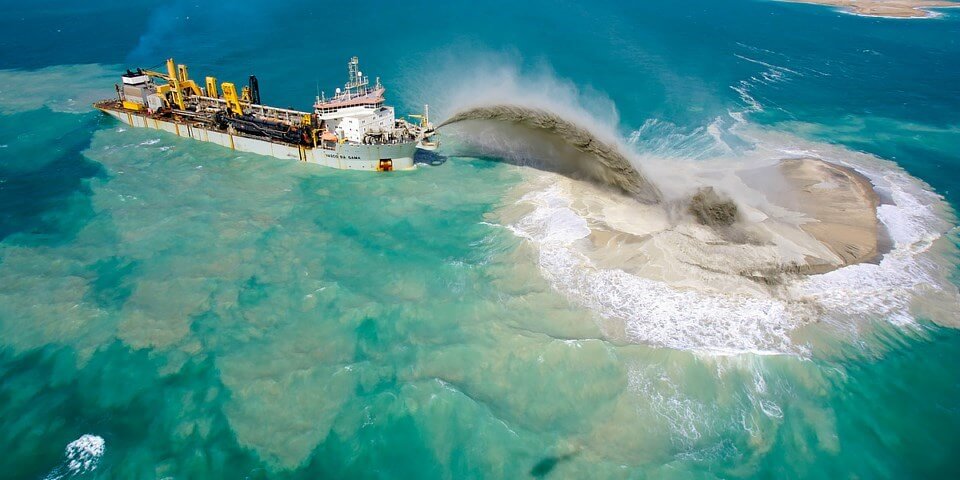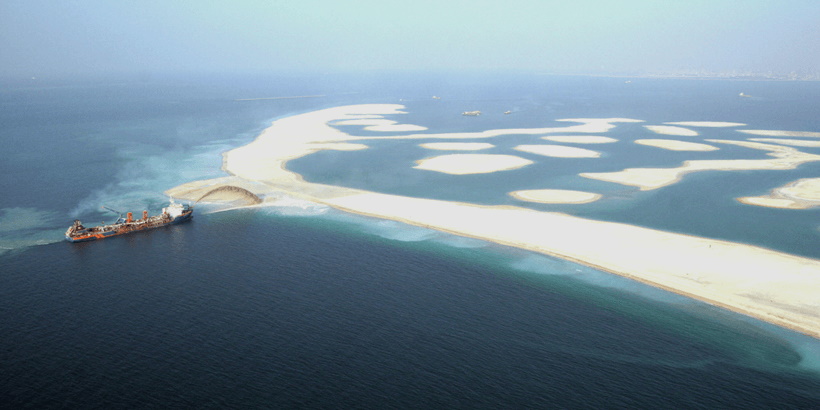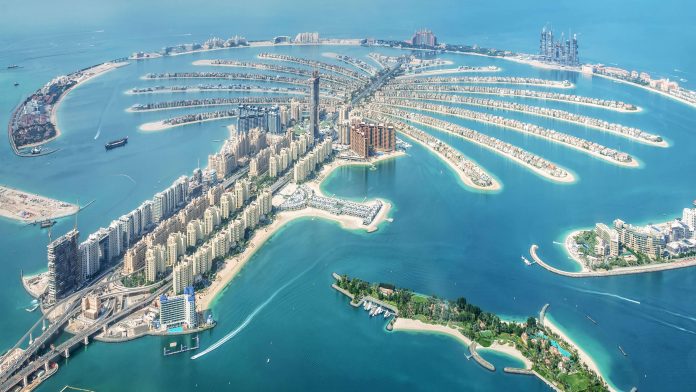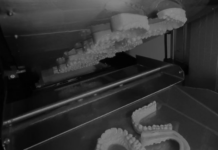Stretching 5km into the Arabian Gulf and shaped like a date palm, Palm Jumeirah is Dubai’s self-styled “eighth wonder of the world”.
The over-the-top emirate is not just blowing its own trumpet though; this man-made island is one of the most audacious engineering projects ever undertaken. Here are 7 fascinating facts about Palm islands:
1.It’s made from millions of tons of rock and sand
Instead of concrete slabs, the foundations of The Palm were created from 7 million tons of rock blasted from the nearby Hajar Mountains. And while the desert emirate is surrounded by sand, 120 million cubic metres of the stuff were dredged from the bottom of the sea to form the island. In fact, the amount of rock and sand used in Palm Jumeirah’s construction could form a 2m-wide wall that would circle the globe three times.

2.An 11km breakwater protects the island
The crescent-shaped breakwater was the first section of The Palm to be built. It protects the inner island from strong sea currents and the seasonal ‘shamal’ winds that blow across the Gulf from Iraq. A geotextile membrane, which stops the sand from washing away, was topped by a layer of one-ton rocks, followed by two more layers of rocks weighing up to six tons each.
A 100m-wide opening was added on each side of the crescent to allow water to circulate and prevent it becoming stagnant. A 6m-wide boardwalk stretches the length of the crescent and is a top spot for a sunset stroll.
3.Engineers used satellites to plot the shape
With the crescent in place, a fleet of sand dredgers worked around the clock to create the trunk and 17 inner fronds. Creating the perfect palm shape called for high levels of precision though. Guided by a hi-tech GPS, the dredgers sprayed the sand into place with pinpoint accuracy. Vibro-compaction technology was used to prepare the 560 hectares of reclaimed land to be built on. The finished island covers an area equivalent to 600 football pitches and is four times as big as London’s Hyde Park.
4.A temporary dam was built
A 6-lane sea tunnel – built using 200,000 cubic metres of reinforced concrete, 30,000 tons of reinforcing steel and 110,000 tons of rock – connects the trunk to the crescent, 25m below sea level. To build the tunnel under dry conditions, two 1.2km-long dykes were constructed to form a dam. More than 5.5 million cubic metres of seawater was pumped out in just 45 days, with around 2,000 fish caught and relocated to prevent them getting trapped inside the drained space. Meanwhile, the dykes were later used as temporary roads for construction vehicles.
5.It took just six years to build
The $12 billion project began in 2001 and six years later, the island’s first residents moved in. Today, the 17 fronds are home to around 1,500 beachfront mansions, with a further 6,000 apartments on the trunk. Major hotels on the crescent include Atlantis The Palm and the Waldorf Astoria, with brands such as Fairmont and Viceroy on the trunk. Resorts in the works include The Royal Atlantis, next to the existing Atlantis resort, and Palm 360, a two-tower resort connected by a 155m-long “sky pool”.

6.A Trump Tower was originally on the cards
Long before Donald Trump turned his attention to becoming President of the United States, he planned a 60-storey hotel on Dubai’s artificial archipelago. Touted as “the striking centrepiece of the island”, the project was quietly shelved in 2009 following the global financial crisis. In 2012, Nakheel opened Al Ittihad Park on the proposed site of the Trump project.
Meanwhile, the underwater-themed Atlantis The Palm remains the flagship resort. It boasts a sprawling waterpark and more than 1500 rooms, including the Royal Bridge Suite that will set you back a cool $25,000 per night.
7.Two more palm-shaped islands were planned
Work on an even larger island called Palm Jebel Ali began in 2002 but also fell foul of the 2008 financial crisis. Land reclamation was completed, but no further development work is planned in the near future. Palm Deira, launched in 2004 and set to be eight times larger than Palm Jumeirah, rounded off the trilogy. Instead, Nakheel has opted for a scaled-back four-island project called Deira Islands. The 1,530-hectare development will eventually include hotels, residential towers, a sprawling mall and a marina.



















































